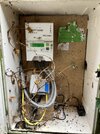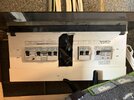For a period of a few years we had some damp in the loft that I think was causing the our RCD to trip, sometimes multiple times a day.
(The leftmost RCD in this picture: HAGER 63 AMP 30mA DOUBLE POLE RCD TYPE AC U762 U2 20470.)
That damp issue is fixed and the RCD has stopped it's daily tripping, but I suspect it might be worn out from those many repeated trippings.
The symptom is that on some days it repeatedly trips when I try to start our treadmill, but on other days it's totally fine.
Acknowledging that it may be an overloaded circuit from the current draw of the treadmill, I'd like to fit a replacement RCD, just to rule out that the RCD is worn out.
I'm attaching a photo of the Consumer Unit, and the electrical box outside. What's the correct way to make the Consumer Unit safe to work on to replace the RCD?
(The leftmost RCD in this picture: HAGER 63 AMP 30mA DOUBLE POLE RCD TYPE AC U762 U2 20470.)
That damp issue is fixed and the RCD has stopped it's daily tripping, but I suspect it might be worn out from those many repeated trippings.
The symptom is that on some days it repeatedly trips when I try to start our treadmill, but on other days it's totally fine.
Acknowledging that it may be an overloaded circuit from the current draw of the treadmill, I'd like to fit a replacement RCD, just to rule out that the RCD is worn out.
I'm attaching a photo of the Consumer Unit, and the electrical box outside. What's the correct way to make the Consumer Unit safe to work on to replace the RCD?



